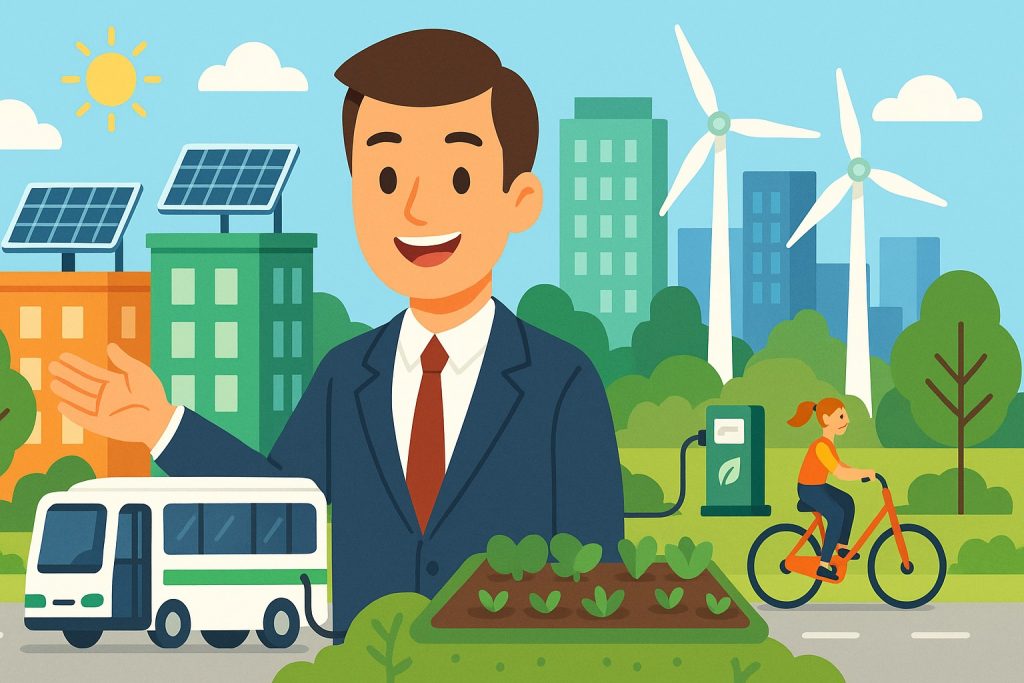As the world confronts climate change, cities play a crucial role in leading the way toward sustainability. With over half the global population living in urban areas, making cities climate-neutral—that is, reducing their greenhouse gas emissions to net zero—is essential for a livable future. But how can a city actually achieve climate neutrality? Let’s explore the key strategies and technologies involved.
1. Renewable Energy Transition
A climate-neutral city must shift away from fossil fuels and embrace renewable energy sources such as:
- Solar power (rooftop panels, solar farms)
- Wind energy (urban turbines or regional grid connections)
- Geothermal and hydropower, where feasible
This involves upgrading the city’s energy grid, investing in storage technologies like batteries, and incentivizing households and businesses to adopt clean energy.
2. Sustainable Transport Systems
Transportation is a major source of urban emissions. To reduce its impact, cities can:
- Expand public transit powered by electricity or hydrogen
- Promote walking and cycling with safe paths and bike-sharing programs
- Support electric vehicle (EV) infrastructure—charging stations, EV taxis, buses, and delivery vehicles
Some cities are adopting car-free zones or low-emission zones to encourage cleaner mobility.
3. Green Buildings and Urban Design
Buildings are another major contributor to carbon emissions. Climate-neutral cities invest in:
- Energy-efficient buildings with smart insulation, LED lighting, and low-energy appliances
- Green roofs and walls to reduce heat and absorb CO₂
- Net-zero construction codes for all new buildings
- Retrofitting old buildings with modern, eco-friendly technologies
Urban planning also plays a role: compact, mixed-use neighborhoods reduce the need for long commutes and lower emissions.
4. Waste Management and Circular Economy
A city striving for climate neutrality must rethink waste. This means:
- Expanding recycling and composting programs
- Implementing zero-waste policies in industries and communities
- Encouraging reuse and repair instead of throwaway culture
- Supporting circular economy initiatives that turn waste into resources
Organic waste can be turned into biogas, helping supply clean energy.
5. Urban Greenery and Carbon Sinks
Even in dense cities, nature-based solutions are vital:
- Planting trees, creating parks, and protecting green spaces
- Developing urban forests and green corridors
- Supporting urban farming and community gardens
These not only absorb CO₂ but also improve air quality, reduce urban heat, and enhance well-being.
6. Smart Technologies and Data Use
Climate-neutral cities harness digital technologies to monitor, manage, and optimize systems:
- Smart grids balance energy use and reduce waste
- IoT sensors track pollution, traffic, and energy flow
- Data platforms support evidence-based policies and citizen engagement
Automation can also streamline public services and cut unnecessary resource use.
7. Community Involvement and Policy Support
Technical solutions alone aren’t enough. Cities need:
- Citizen participation in climate planning and local initiatives
- Educational campaigns to shift behavior and raise awareness
- Incentives and subsidies for eco-friendly choices (e.g., solar panels, electric bikes)
- Strong governance that aligns local policies with national and global climate targets
Only by aligning community values with climate goals can long-term progress be sustained.
Glossary
- Climate-neutral — Achieving a balance between emitting carbon and absorbing it from the atmosphere
- Greenhouse gases — Gases like CO₂ and methane that trap heat in the Earth’s atmosphere
- Circular economy — An economic model focused on reuse, recycling, and minimizing waste
- Net-zero — A state where the amount of emissions produced is balanced by removal or offsetting measures
- Smart grid — An electricity supply network that uses digital communications to detect and react to local changes


